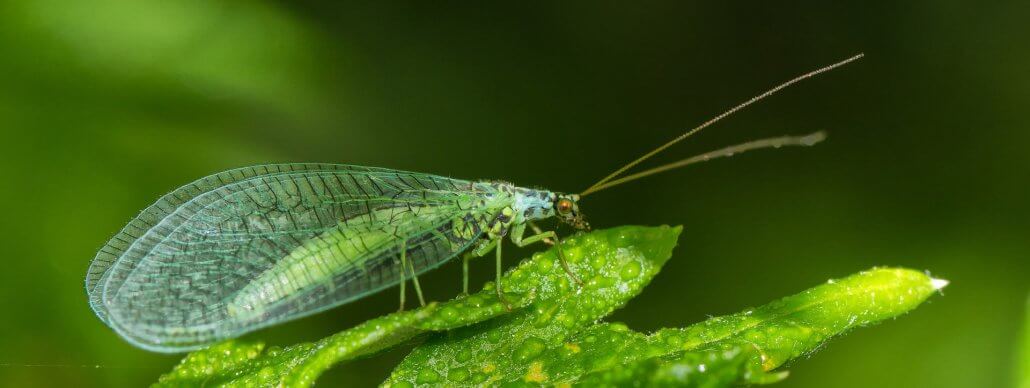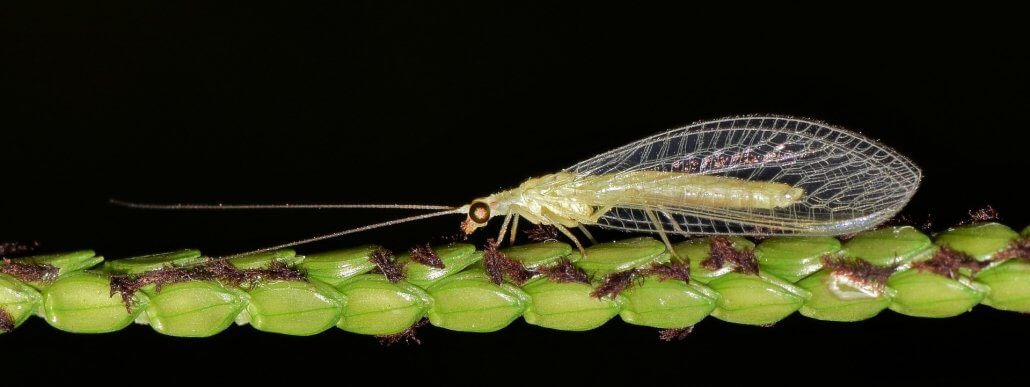What on earth is a green lacewing? This question might have been on many of the Trace & Save farmers’ minds in 2020 with the new biodiversity survey we’ve implemented. This article will answer the questions: what is a green lacewing and why is it relevant to a pasture-based dairy farm?
Taxonomy & morphology
Green lacewings are a family group, called Chrysopidae, consisting of different species with very similar characteristics. The family forms part of the order Neuroptera which characterises net winged insects including, for example, antlions.
Adult green lacewings, as the name might suggest, are green bodied insects with netted (laced) wings. Their bodies are 15-20mm long with a wingspan up to 5cm wide. Adults have relatively large, golden, compound eyes. Larval and adult stages of a green lacewing look very different. The larvae, nicknamed aphid-lions, have flattened bodies that can grow up to 2.5 cm long, with no wings. They have large, curved mandibles that make them efficient predators and beneficial to any farmer. Their colour is mottled with variations of white, brown and grey.
Importance
Green lacewings’ have been undervalued by many producers. They are ferocious predators of small, soft-bodied insects (e.g. aphids, lice, mites, and caterpillars) as well as insect eggs. Each individual larva will consume at least 200 other small insects per week. This makes them beneficial and desirable creatures to have around as they play a big role in pest control on pastures and crops.
They are susceptible to insecticides, therefore by spraying insecticide, you will lose out on the natural pest-control these insects offer. We encourage you to only use chemical insecticides as a last resort and set up an integrated pest management plan, starting with incorporating multispecies pastures.
Having these insects present, tells us something more about the pasture/field that is valuable to know. Green lacewings are bio-indicators of a diverse insect population and changes in the number of green lacewings observed, can be an indication of something else changing in the balance and health of the agro-ecosystem (Deutsch, 2005).
How can I find them in my pasture?
Adult green lacewings are nocturnal which means they are active at night. They are also attracted to light. If you happen to be out on the pasture at night, be sure to keep an eye out for these insects, as well as on the outdoor lights on various buildings on the farm.
The larvae are small and generally well camouflaged. Keep an eye out for them on the leaves and stems of plants where pest-infestations occur.
The eggs are laid on hair-like stalks on the leaves to prevent the eggs from being predated on by other insects as well as their brothers/sisters. These cannibalistic tendencies are actually a good thing because at large densities they will eat each other. Thus, controlling their population densities as well as others. Look out for the eggs laid close by to any aphid infestations.
Conclusion
We want to highlight green lacewings for the biocontrol species that they are, and even more importantly what their presence on a farm indicates – a healthy agro-ecosystem.
References
Deutsch, B. & Paulian, Mihaela & Thierry, Dominique & Canard, Michel. (2005). Quantifying biodiversity in ecosystems with green lacewing assemblages. http://dx.doi.org/10.1051/agro:2005036. 25. 10.1051/agro:2005036.
- Protozoa and protozoa tea - 2021-04-07
- Green lacewings - 2021-03-01
- Understanding the black gold of the earth – humus. - 2021-02-02


